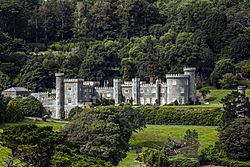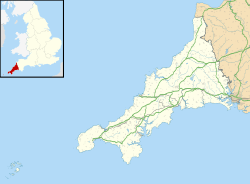Caerhays Castle facts for kids
Quick facts for kids Caerhays Castle |
|
|---|---|
| Cornwall, England, UK | |

The castle from the south east
|
|
|
Location in Cornwall
|
|
| Coordinates | 50°14′23″N 4°50′48″W / 50.2396°N 4.8467°W |
Caerhays Castle (also called Carhayes Castle) is a special kind of old house in Cornwall, England. It's like a big country house that looks a bit like a castle. It sits about 0.5 miles (0.8 km) south of a village called St Michael Caerhays. The castle looks out over Porthluney Cove and the English Channel.
One of the most famous things about Caerhays Castle is its amazing garden. It has the largest collection of magnolia trees in the whole United Kingdom! It's even one of the special National Magnolia Collections.
Contents
History of Caerhays Castle
Early Owners and Changes
Long, long ago, in the Early Middle Ages, the land where Caerhays Castle now stands belonged to the Arundell family. The first time we see the name "Caerhays" written down was in 1259.
Around 1379, the estate became part of the Trevanion family. This happened when Robert Trevanion married Johanna Arundell, who was the daughter and heir of the Arundell family from Caerhays. Later, in 1703, John Trevanion took over the estate. He made the old house bigger and started creating the beautiful gardens.
Building the Current Castle
In 1767, William Trevanion passed away. The estate then went to his sister's son, John Bettesworth. John's son, John Bettesworth-Trevanion, decided to build the castle we see today. He started building it between 1807 and 1810. The famous architect John Nash designed the castle. It was built near where the older house used to be.
The Williams Family Takes Over
After some time, John Bettesworth-Trevanion had to leave for Paris because he couldn't pay his bills. In 1854, Michael Williams II bought Caerhays from the people he owed money to. The house had been empty for more than ten years and wasn't in good shape.
Michael Williams II's younger brother, Sir William Williams, 1st Baronet, of Tregullow, and his son, John Michael Williams, started a big project to fix up the castle. When Michael Williams II died in 1858, his eldest son, John Michael Williams, inherited Caerhays.
Later, in 1880, John Michael Williams's second son, John Charles Williams, inherited the estate when he was only 18. When he got married in 1884, the house was restored and changed again. John Charles Williams became very interested in plants. He even helped pay for trips to find new plants around the world to fill the castle garden. Seeds brought from China in 1903 were given to him, making the garden even more special. Today, Charles Williams is the owner of Caerhays Castle.
What Caerhays Castle Looks Like
The outside of Caerhays Castle looks like an old Norman castle. It was built using rough stone from nearby quarries. The main entrance is about 160 feet (49 meters) long and faces south. It sits on a raised terrace with battlements, which are the parts of a castle wall with gaps for defense.
Inside, the main rooms are on the south and east sides. They are connected by a large gallery room. The windows in the dining room, staircase, and entrance hall have beautiful painted glass.
Some parts of the very first house are still there. This includes an old chapel and a path that leads to the sea, which is still called the Watchhouse Walk.
Protecting Caerhays Castle
Caerhays Castle is a very important historical building. On November 15, 1988, it was given a special status as a Grade I listed building. This means it's one of the most important historic buildings in England and is protected.
Other parts of the estate are also protected. This includes the garden wall with its gates and a folly tower (a building made to look old or interesting). The Higher Lodge, the Lower Lodge, and the service buildings near the castle are also listed as important historic structures.
The Amazing Garden
The garden at Caerhays Castle is huge, covering almost 120 acres (0.49 km²)! You can explore it using four different paths: the Red Route, Blue Route, Yellow Route, and Green Route. There are also trails, grassy paths, and steps to follow.
The garden is home to about 600 different kinds of plants, including trees and shrubs like azaleas and camellias. By 1917, it already had over 250 types of rhododendrons! As mentioned before, the garden has the largest collection of magnolia trees in the United Kingdom. It's a wonderful place to see many different and rare plants.
Images for kids







